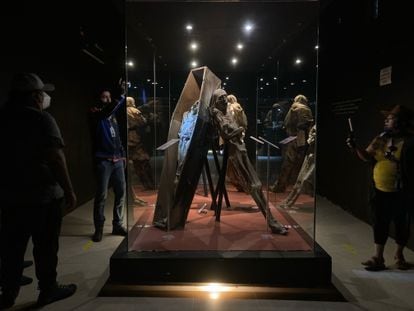Visitors observe the mummies of Guanajuato, in October 2021. Andrea Murcia (CUARTOSCURO)
The National Institute of Anthropology and History (INAH) does not want to leave loose ends in Mexico's past.
That is why it has been proposed to solve one of the most famous archaeological mysteries in the country: what is the authentic identity of the mummies of Guanajuato, one of the main tourist attractions of the city that causes thousands of people a year to travel to the state capital of the same name.
The institution said in a statement released this Monday that "the objective of the research project is to restore their identity and dignity to each of the mummified bodies", more than 100 mummies that are exhibited in the showcases of a museum dedicated to them.
To do this, the INAH has formed a special commission made up of four experts in the field of Physical Anthropology —a discipline that is responsible for shedding light on the evolutionary history of the human species—.
The team is made up of María del Carmen Lerma Gómez, Israel David Lara Barajas, Ilán Leboreiro Reyna and Leslie Julieta Cabriada Martínez, and will be coordinated by the director of the institution's Department of Physical Anthropology (DAF), Juan Manuel Argüelles San Millán.
In the second half of the 19th century, bodies began to be exhumed from the Santa Paula pantheon, which appeared mummified.
That is, corpses with an acceptable state of preservation long after their death.
Either due to the environmental conditions of the place where they are found —dry, cold, isolated— or due to human intervention, through embalming or other practices, such as the famous mummies of Egypt.
The most common mummies are those that have been produced by human action, since achieving the necessary conditions for their conservation in a natural state is something fortuitous and unusual, as explained on the website of the Guanajuato Mummy Museum.
The richness of the latter lies precisely in the fact that they belong to those rare and precious specimens that are mummified naturally.
"Its state of mummification is explained by the lack of oxygen and moisture exchange with the outside of the drawers," explains the museum.
Interior view of the Museum of the Mummies of Guanajuato.
Andrea Murcia (DARKROOM)
The director of the DAF and in charge of coordinating the team of specialists, Argüelles San Millán, develops in the INAH statement that "these mummified bodies acquire importance not only for their natural preservation, but also because they are inhabitants of the ancient city of Guanajuato, whose remains have endured and have unique characteristics that allow their story to be told.”
Although the commission of researchers will have to face several technical difficulties: in the 150 years that the mummies have been exposed to the public, the conservation process has not been adequate, according to the expert.
The clothes they were wearing have been lost and have deteriorated.
The INAH considers that identifying the remains of the corpses will be key to better understanding the past of Guanajuato.
The research is about "a priority need to grant heritage value and highlight its relevance."
Lacking an identity, some of the bodies have received popular nicknames over time, such as
El Ahogado
,
La china
or
La Bruja
.
And beyond the tourist interest, it has been left in a "second term" that it is about "bodies of people who had a name, an age, who had and, perhaps, still have a family".
The team of specialists has already made a first foray into the city of Guanajuato to prepare a work plan that they will follow.
The process will require a deep investigation and diving into all possible archives in search of documents that may shed light on the mystery.
“The proposed methodology is precise and seeks to obtain a conservation diagnosis of the mummified bodies, recover the background of each one so that, as far as possible, their date of death can be identified and known, and together with other scientific data. determine its patrimonial status, dignify and safeguard this peculiar and important heritage”, adds Argüelles San Millán in the statement.
The announcement has come just a few months after a controversy surrounded the mummies of Guanajuato.
The mayor of the city, Alejandro Navarro Saldaña —of the PAN—, approved the construction of a new museum that will be included in a shopping center.
Numerous experts, INAH itself or UNESCO have been adamantly opposed, and dismiss the initiative as an attempt to increase private profits that leaves science aside.
subscribe here
to the
newsletter
of EL PAÍS México and receive all the informative keys of the current affairs of this country















